Introduction
Did you know product data enrichment is now essential in a world with 30.7 million online stores, where 73% of consumers feel overwhelmed while shopping? This overwhelming digital landscape creates significant challenges for both shoppers and retailers. 70% of potential customers abandon product pages simply because information is unclear or missing.
The consequences of poor product data are far-reaching. Nearly half of customers return items because they don’t match online descriptions. At the same time, three in four shoppers feel bombarded by product page noise, and 72% can’t determine if products will deliver on promises. Furthermore, approximately 87% of online shoppers rely on detailed descriptions before making purchase decisions.
We understand these challenges firsthand and recognize the critical importance of e-commerce search enrichment for business success. Ultimately, 74% of people walk away from purchases because they lack the right information to make informed decisions. Throughout this guide, we’ll explore what product data enrichment means for e-commerce, why it matters, and how implementing the right strategies can transform your online retail performance. Specifically, we’ll cover essential PIM systems and GDSN strategies that help optimize product data and create shopping experiences that convert browsers into buyers.
Key Takeaways
- Poor product data costs sales: 70% of customers abandon pages with unclear information, and 87% won’t buy from retailers with inaccurate data
- Enrichment reduces returns significantly: Nearly half of customers return items because they don’t match online descriptions—enriched data prevents this costly issue
- PIM systems centralize and automate: These platforms serve as single sources of truth, managing millions of SKUs while automating enrichment workflows across channels
- GDSN enables global synchronization: This network standardizes product data exchange worldwide, complementing PIM systems for international market distribution
- Four-step implementation works: Collect and audit data, standardize and cleanse, enrich with attributes and media, then validate and integrate across platforms
- When properly implemented, enriched product data increases conversion rates by 20-40%, reduces return rates below 10%, and can boost revenue per user by up to 15%. The combination of PIM systems for internal management and GDSN for global distribution creates a powerful infrastructure that transforms product listings into compelling sales tools that build customer confidence and drive sustainable e-commerce growth.
Understanding Product Data Enrichment in Ecommerce
Product information serves as the digital equivalent of a sales associate in the online shopping world. When shoppers can’t physically examine items, the quality of product data becomes the deciding factor between making a sale or losing a customer.
What is product data enrichment?
Product data enrichment transforms basic product information into comprehensive, valuable content that drives purchasing decisions. This process involves enhancing raw product data with additional layers of information to make items more accurate, appealing, and useful to customers.
Consider this stark contrast in product descriptions:
Before enrichment: “Holiday wreath, 18-inch diameter, spray foam, plastic pinecones, wire hanger, rated for outdoor use.”
After enrichment: “Festive holiday wreath to complement any front door or porch. Enjoy the sights of the seasons and feel the holiday cheer with decorative ‘snow,’ winterized pinecones, and fluffy evergreen branches.”
The enrichment process typically enhances several key elements:
- Detailed descriptions and specifications
- High-quality images from multiple angles
- Technical attributes (dimensions, weight, materials)
- Marketing content (titles, descriptions, SEO tags)
- Customer reviews and ratings
- Availability and shipping information
- Related product recommendations
Through this enhancement, product data becomes more machine-readable, semantically accurate, and complete—helping AI systems match products with the right queries and shopper behaviors.
Data Enrichment vs. Data Cleansing
Many organizations confuse data enrichment with data cleansing, yet they serve distinct purposes in product data management:
Data Cleansing
Data Enrichment
Fixes problems in existing data |
Adds missing details, removes repetitive info |
Corrects inaccuracies and inconsistencies |
Ensures data integrity and accuracy |
Improves data quality beyond mere correction |
Enhances value by adding new context and details |
Supplements with information from external sources |
Makes data more useful and insightful |
As one expert explains, “Data cleansing is all about fixing problems…however, product data enrichment is about improving your data, not necessarily ‘fixing’ it.”
Additionally, whereas cleansing focuses on identifying and eliminating errors, enrichment expands your data’s value by adding depth and context. Both processes are essential steps in maintaining data quality, yet they serve different stages in the data management lifecycle.
Why Enriched Product Data Matters for Ecommerce
The impact of enriched product data on e-commerce performance is substantial and measurable:
First, enriched data prevents customer overwhelm. With three in four people abandoning carts when they feel bombarded by product information, presenting clear, valuable content helps customers confidently complete purchases.
Moreover, enriched product data significantly reduces returns. Approximately 40% of consumers have returned online purchases because the product content wasn’t detailed or accurate enough. According to a Power Reviews survey, nearly half of all customers return items simply because they don’t match the online description.
Perhaps most compelling, enriched data builds customer trust. A staggering 87% of consumers won’t do business with retailers displaying inaccurate product data, costing thousands in unrealized revenue and negative reviews. Simultaneously, 87% of online shoppers consider product descriptions crucial to their buying decisions, with nearly 70% abandoning product pages when descriptions are poor or incomplete.
Consequently, enriched product data creates a virtuous cycle of business benefits:
- Increased product visibility through better search rankings
- Faster buying decisions from shoppers who have all the necessary information
- Improved performance of dynamic ads pulling from enriched feeds
- Reduced friction in the buyer’s journey
- Enhanced ability to segment and target customers effectively[10]
For B2B businesses, particularly, enriched content addresses the complex decision-making process involving multiple stakeholders by providing detailed specifications, compatibility information, and technical documentation.
Types of Product Data to Enrich for Retail Success
Successful retailers recognize that product data falls into distinct categories, each requiring targeted enrichment strategies. Breaking down your product data into these types makes the enrichment process both manageable and effective.
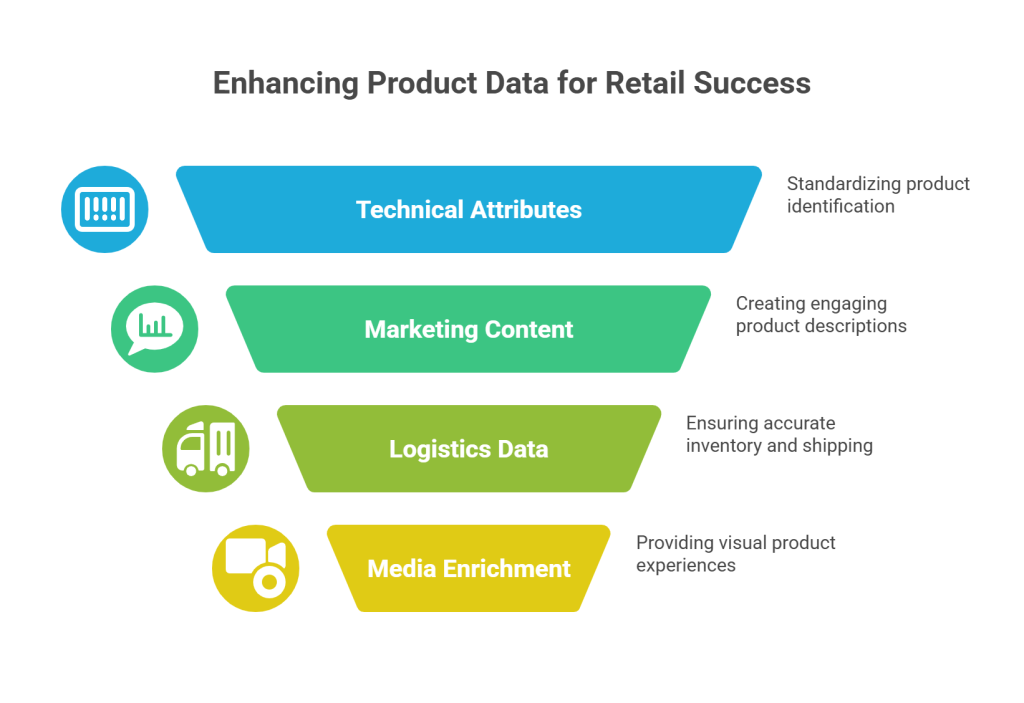
1. Technical Attributes: GTIN, MPN, Dimensions
Technical attributes form the backbone of product identification and standardization. These identifiers help algorithms, databases, and systems recognize and categorize your products accurately.
Global Trade Item Numbers (GTINs) serve as universal product identifiers that define what you’re selling in the global marketplace and can substantially boost the performance of your ads and free listings. Similarly, Manufacturer Part Numbers (MPNs) uniquely identify specific products among all offerings from the same manufacturer.
Physical specifications such as dimensions and weight require standardized measurement approaches:
- Height: Measured from base to top
- Width: Measured from left to right
- Depth: Measured from front to back
For product weight, differentiating between net weight (product only) and gross weight (product plus packaging) provides essential clarity for both logistics and customer expectations. Properly defined technical attributes ensure your products appear in relevant search results and comparison shopping engines.
2. Marketing Content: Titles, Descriptions, SEO Tags
Marketing content creates the emotional and informational bridge between your products and potential customers. Well-structured product titles should follow a format that prioritizes the most searchable information first, typically including brand, product type, key features, and variations.
Product descriptions serve as your digital sales pitch. Compare these approaches:
Basic description: “1200W LED Floodlight”
Enriched description: “1200W LED Floodlight, Outdoor Waterproof, Energy Efficient – Ideal for gardens and parking lots, featuring overvoltage protection and compatible with smart home systems”
Meta descriptions function as mini-advertisements, providing relevant summaries that convince users a page matches their search intent. For optimal results, include specifics like author information for blog posts or key product details (price, manufacturer, specifications) for product pages.
Notably, enriched marketing content reduces returns—nearly half of customers return items because they don’t match online descriptions. Through detailed content enrichment, your products become more discoverable while setting accurate customer expectations.
3. Logistics Data: Availability, Shipping, Inventory
Logistics data provides critical operational information that influences purchasing decisions. Real-time inventory availability delivers available-to-sell data for eCommerce channels at both single-node and network levels, preventing overselling and underselling.
Enriched inventory data typically includes:
- Current availability (on-hand quantity)
- Future availability (quantity available at a future date)
- Shipping information (costs, speeds, locations)
- Stock availability (with limited-time promotional indicators)
When customers request to purchase items, enriched inventory models check available stock locations with the required product and total quantity to determine availability. Different inventory model strategies then determine how orders are fulfilled—whether through single shipments or multiple shipments from different locations.
Through logistics data enrichment, customers gain transparency about when and how they’ll receive products, significantly improving their shopping experience.
4. Media Enrichment: Images, Videos, 3D Assets
Visual content plays a decisive role in purchasing decisions. Enriched media assets should include:
- High-resolution images from multiple angles (minimum 5-7 per product)
- 360-degree product views for complex items
- Videos demonstrating product usage and benefits
- Size comparison visuals with familiar objects
Interactive 3D and augmented reality (AR) experiences are increasingly important—78% of customers prefer 3D experiences on product pages. These technologies allow customers to rotate and zoom in on products to get a “feel” for materials, details, and quality, bridging the gap between online and offline retail.
Modern AR implementations don’t require customers to download plugins or apps; they can simply scan QR codes with mobile devices or directly view products in AR when visiting mobile pages. This interactivity reduces the risk of mismatched expectations, ultimately leading to higher conversions and lower return rates.
By thoughtfully enriching these four types of product data, retailers create comprehensive digital product experiences that satisfy both algorithms and human shoppers—turning browsers into confident buyers.
Benefits of Product Data Enrichment for E-commerce Brands
The strategic value of product data enrichment extends far beyond mere organization—it directly impacts your bottom line. Enriched product information delivers measurable benefits that can transform your ecommerce performance across multiple business dimensions.

1. Improved Ecommerce Search Enrichment and Discoverability
Enriched product data substantially enhances how customers find your products, both on your site and across the digital landscape. Unlike traditional searches that rely on basic keyword matches, enriched search uses advanced technology to understand the meaning behind user queries. For instance, a search for “running shoes for flat feet” with enriched data will display specifically designed footwear rather than generic running shoes.
This enhanced discoverability yields significant results:
- Increases traffic and visibility by up to 50%
- Helps search engines and shopping platforms display products in relevant search results
- Enables products to rank higher for popular search terms through improved SEO
Visitors using e-commerce search functions are three to five times more likely to convert into paying customers. Through careful enrichment, your products become more visible to consumers actively searching for what you offer.
2. Higher Conversion Rates and Reduced Returns
The impact of enriched data on conversion and retention is substantial. Detailed product information helps customers make confident purchase decisions, resulting in:
- Increased purchase likelihood by up to 30%
- Conversion rate improvements of 20-40% with optimized search
- Return rates reduced to below 10%
The economic rationale is clear—approximately 40% of people return online purchases because product content wasn’t detailed or accurate. Alternatively, comprehensive product details minimize misunderstandings between customer expectations and actual products.
Consider that nearly half of customers return items simply because they don’t match online descriptions. By setting accurate expectations through enriched data, you substantially decrease costly returns while increasing customer satisfaction.
3. Better Customer Experience and Trust
Trust has become a critical currency in ecommerce, with enriched product data serving as its foundation. A remarkable 87% of consumers refuse to do business with retailers displaying inaccurate product data. Additionally, the same percentage base their purchasing decisions on product descriptions.
Enriched data builds customer confidence by:
- Providing everything customers need to make informed decisions
- Allowing them to view products from multiple angles
- Offering comprehensive specifications and usage information
- Enabling product comparisons with competitors
Correspondingly, this enhanced information leads to greater customer satisfaction and loyalty. Companies focused on customer experience through enriched data typically earn 4-8% more than their competitors.
4. Enhanced Product Feed Enrichment for Ads and Marketplaces
Product feed enrichment forms the foundation of effective ecommerce campaigns across platforms. The quality of your data feed determines not only product discoverability but also provides a major competitive advantage.
Enriched product feeds deliver measurable improvements:
- Higher Quality Scores and more relevant ad placements
- Improved targeting and performance across shopping campaigns
- Better visibility in AI-powered discovery engines
Indeed, product feed data is the foundation of all ecommerce shopping campaigns—performance will only be as good as your data. This is especially important as platforms like Google use product feed data to match products with consumer search queries.
By enriching product titles, accurate attributes, and optimizing images, you help platforms better understand your items. Ultimately, feed enrichment provides a proven way to boost performance, making it an essential part of your ecommerce strategy.
Companies implementing enriched product data see substantial results—Aberdeen Strategy & Research reports increased lead conversion rates by 36%, while many Fortune 500 companies experience 50% growth in sales and customer satisfaction.
Challenges in Managing and Enriching Product Data
Even with the clear benefits of product data enrichment, companies face substantial hurdles when implementing these practices on a scale. These challenges can significantly impact your ability to deliver accurate, consistent product information across channels.
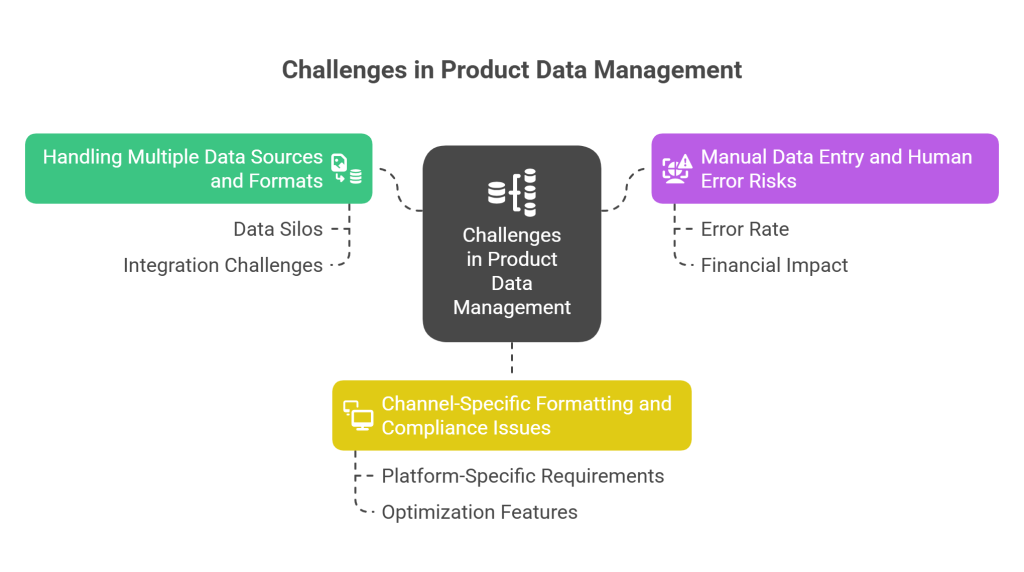
1. Handling Multiple Data Sources and Formats
The volume and diversity of data sources create major obstacles for effective product data enrichment. Data owners must contend with information flowing from various touchpoints—online transactions, customer service interactions, and social media—while simultaneously managing product specifications, pricing, and inventory details. This varied data landscape makes maintaining accuracy and consistency extraordinarily difficult.
Data silos represent another significant barrier, where information becomes isolated in different systems or departments. These silos lead to duplication, inconsistency, and difficulties accessing data across your organization. Subsequently, this fragmented environment hinders your ability to derive comprehensive insights and make informed decisions.
Integration challenges further complicate matters. When gathering product data from different suppliers, manufacturers, or vendors, the information often arrives in incompatible formats and structures. To overcome this obstacle, you must integrate the data into a unified format through processes like:
- Data mapping to standardize structure
- Transformation and cleansing to remove inconsistencies
- Regular monitoring to maintain accuracy
2. Manual Data Entry and Human Error Risks
Despite technological advances, manual data entry remains common—yet problematic—in product data management. The error rate in manual data entry can reach up to 4%, meaning without verification, your company could produce 400 errors for every 10,000 entries. These errors become increasingly problematic when data must be entered into multiple systems, as the probability of mistakes increases significantly.
The manual process is inherently time-consuming and tedious. As one industry expert notes, “manual data entry is very beneficial for small businesses, but it still restricts the expansion of the industry and obstructs its progress”. The repetitive nature makes it mind-numbing, particularly during peak seasons when data volumes increase dramatically.
The financial impact is equally concerning. In the United States alone, the potential cost of bad data caused by human error is approximately $3.10 trillion annually. Additionally, employing personnel dedicated to data entry incurs ongoing salary and training expenses.
3. Channel-Specific Formatting and Compliance issues
Each ecommerce platform imposes unique data format requirements, creating a complex challenge for multichannel sellers. Poorly prepared product listings are like “opening a store with messy shelves and unclear labels,” creating confusion for potential customers.
Character limits, keyword preferences, and image specifications differ across platforms. For instance, special characters, line breaks, or even quotation marks that enhance readability on your website can cause havoc on social media platforms, leading to data rejection or distorted product listings.
Nonetheless, ignoring these variations can hurt your reach and sales. Each platform has its own quirks and best practices—some prioritize listings with specific keywords or high-quality images. Generic listings won’t leverage these optimization features, making it harder for potential customers to find your products.
Altogether, addressing these challenges requires thoughtful strategies and appropriate tools. Although complex, overcoming these obstacles is essential for creating consistent, enriched product data that drives ecommerce success.
Role of PIM Systems in Product Data Enrichment
In an era where managing product information can make or break your e-commerce success, Product Information Management systems emerge as the backbone of effective data enrichment strategies. These specialized platforms transform how businesses handle, enhance, and distribute product information across the digital landscape.
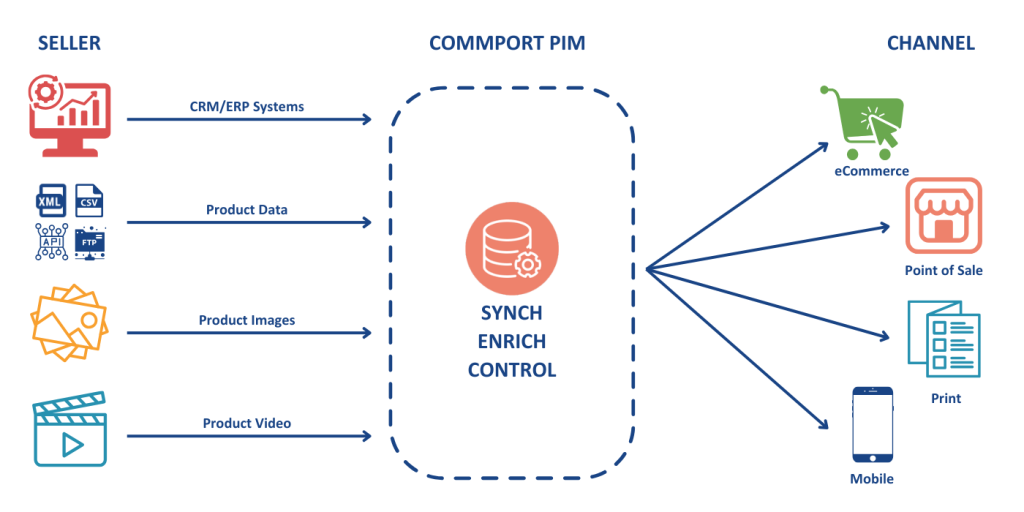
What is a Product Information Management (PIM) system?
A PIM system serves as a centralized repository designed specifically for storing, managing, and enriching complex product information. Unlike traditional databases or spreadsheets, a PIM acts as a dedicated platform that lets users consolidate all product-related data—including specifications, descriptions, pricing, and digital assets—in one unified location.
Essentially, these systems function as a “single source of truth” for your entire product catalog, ensuring that all stakeholders work with consistent, accurate information. PIM systems integrate seamlessly with most ecommerce platforms, customer relationship management (CRM) tools, and enterprise resource planning (ERP) software, creating a cohesive ecosystem for your product data.
For businesses with constantly evolving product catalogs, marketing strategies, or sales messaging, PIM solutions provide the infrastructure needed to maintain data integrity across operations.
Centralizing Product Data for Multichannel Distribution
One of the primary advantages of PIM systems lies in their ability to centralize fragmented product information. Initially, PIM platforms aggregate data from various sources, including ERPs, CRMs, and other business systems. Once integrated, this data undergoes automatic processing and deduplication, eliminating the need for manual updates that often lead to errors.
After centralizing your data, PIM solutions organize it into structured catalogs linked to specific distribution channels. This organization method enables your team to:
- Arrange information in easily digestible formats
- Remove data silos that hamper productivity
- Ensure consistency across all customer touchpoints
- Tailor content for different markets or platforms
Due to this centralized approach, businesses can distribute product information to multiple channels while maintaining consistency and accuracy. As a result, customers receive the same high-quality information regardless of where they encounter your products.
Automating Enrichment Workflows with PIM Software
The true power of PIM systems shines through their automation capabilities for product data enrichment. These platforms incorporate rule-based workflows that automatically validate data completeness and quality, dramatically reducing the manual effort typically associated with enrichment processes.
Most modern PIM solutions can effortlessly manage millions of SKUs with thousands of attributes, making them invaluable for businesses with extensive product catalogs. Through automated enrichment, PIM systems can:
- Identify and fill gaps in product catalogs
- Update product information automatically across channels
- Apply predefined rules for data standardization
- Ensure compliance with channel-specific requirements
For marketing teams, PIM automation enables on-demand content changes and rapid launch of new materials. Product descriptions, technical specifications, and visual assets can be enriched and updated simultaneously across all channels, ensuring that customers always receive the most current information.
Commport Datapool Solutions, PIM, and GDSN Help You Centralize, Enrich, and Syndicate Product Data in Real Time to All Your Trading Partners, Improve Product Reach to Global Consumers, and Increase Sales
The efficiency gains from PIM-automated enrichment are substantial. By streamlining onboarding for new products and accelerating update processes, businesses can reduce time-to-market and respond more quickly to changing market conditions. Moreover, with built-in analytics, teams can track which product information performs best, optimizing future content strategies for even greater impact.
As product data continues growing in complexity, PIM systems provide the scalable infrastructure needed to maintain high-quality enrichment practices without proportionally increasing resource requirements. This combination of centralization, automation, and distribution capabilities makes PIM systems indispensable tools in the modern product data enrichment arsenal.
Download: GDSN Buyers Guide
Empower your business with global data synchronization; download our GDSN Buyer's Guide today and take the first step towards streamlined, accurate, and compliant product data management.
Leveraging GDSN for Global Product Data Synchronization
Expanding global business operations requires standardized communication about product information across the supply chain. The Global Data Synchronization Network offers a solution that extends beyond internal systems to create worldwide data harmony.
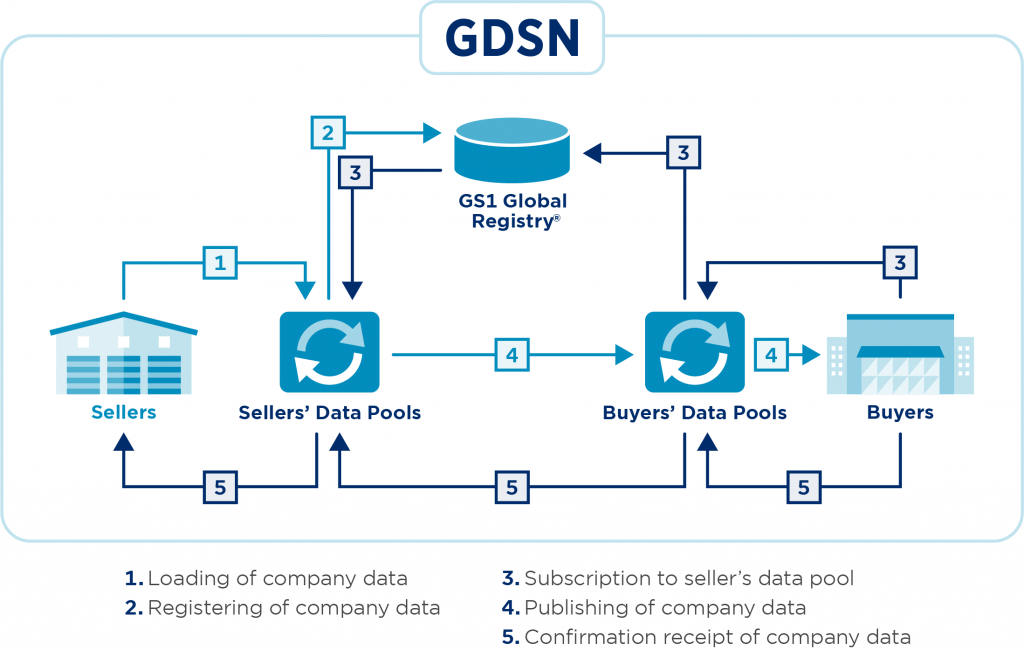
What is GDSN and How it Works
The Global Data Synchronization Network (GDSN) functions as an interconnected system of interoperable data pools enabling businesses worldwide to exchange standardized product information seamlessly. Managed by GS1, this network ensures product data remains accurate, consistent, and up-to-date across all trading partners.
GDSN operates on a publish/subscribe model where suppliers publish product information to data pools, which then match this data to known subscribers. This continuous process guarantees all stakeholders receive the latest product information, from pricing details to party-specific attributes.
The information flow follows a structured pattern:
- Suppliers submit item information to source data pools
- Source data pools register items in the global registry
- Retailers subscribe to items through recipient data pools
- Data synchronizes between the source and recipient pools
- Retailers receive and confirm information
Through this synchronized ecosystem, trading partners can publish or subscribe to item information through a single, consistent process. Henceforth, organizations gain access to continuously updated product data in real-time, automatically synchronized for international market distribution.
While both systems handle product information, their functions differ fundamentally yet complement each other perfectly. PIM systems primarily focus on internal management and distribution of product data across multiple platforms, whereas GDSN specializes in global synchronization of standardized product data.
The ideal integration involves using PIM as the central database for enriched product information, which then feeds into GDSN for distribution to trading partners. This approach creates a seamless flow where:
- PIM gathers and validates product data from various sources
- Data undergoes enrichment and optimization within the PIM
- Validated data transfers to GDSN for global distribution
Commport Datapool Solutions, PIM and GDSN Help You Centralize, Enrich and Syndicate Product Data in Real Time to All Your Trading Partners, Improve Product Reach to Global Consumers and Increase Sales
For manufacturers, this integration means faster product launches and reduced manual effort, as PIM automation detects errors and omissions while facilitating compliance with GS1 standards.
Ensuring Compliance and Data Accuracy Across Regions
The GS1 Global Data Model (GDM) standard underpins GDSN by defining a globally consistent set of foundational product attributes needed for listing, ordering, storing, moving, and selling products. This model creates a structured approach to data organization through four distinct layers:
- Global Core attributes (required across all categories globally)
- Global Category attributes (specific to product categories globally)
- Regional Category attributes (specific to regions and categories)
- Country/Local attributes (specific to countries within regions)
These layers ensure compliance with varying requirements across markets. For instance, allergen statements may be mandatory in North America but optional elsewhere.
The economic benefits are substantial—GDSN simplifies global trade through uniform terminology, common business rules, and implementation guidelines. Businesses failing to comply risk losing trading partners who may switch to GDSN-compliant suppliers, resulting in revenue and market share losses.
By leveraging GDSN alongside PIM systems, businesses create a comprehensive product data ecosystem that maintains accuracy from internal management through global distribution.
Step-by-Step Guide to Implementing Product Data Enrichment
Implementing effective product data enrichment requires a methodical approach with clearly defined steps. Following this framework ensures your product information becomes a valuable asset rather than a liability for your ecommerce operations.
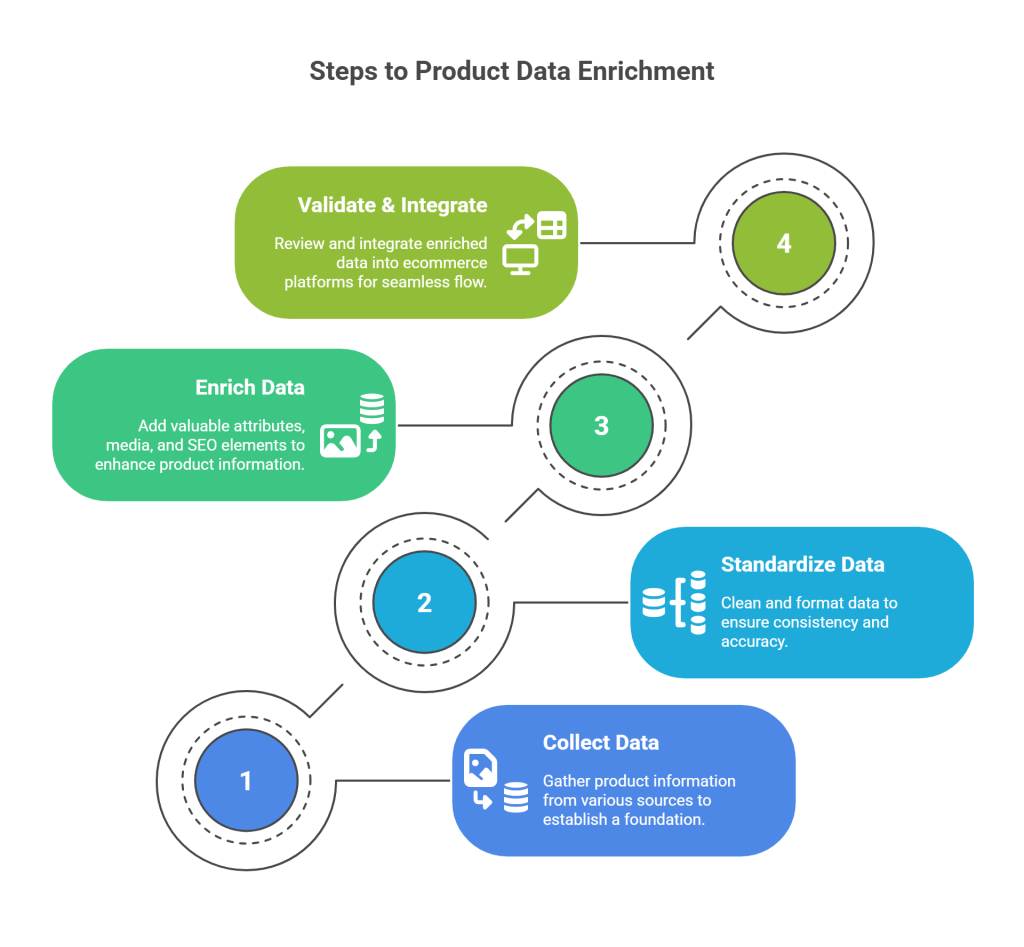
Step 1: Collect and Audit Raw Product Data
Begin by gathering product information from multiple sources, including vendor portals, supplier databases, specification sheets, and internal systems. This collection phase establishes the foundation for all subsequent enrichment activities. For large catalogs, consider using advanced AI tools that extract and prepare raw data, ensuring a solid foundation for attribute enrichment. During this stage, conduct a thorough data audit to identify missing fields, inconsistencies, and quality issues that need addressing. This evaluation reveals gaps between your current data state and desired enrichment goals.
Step 2: Standardize and Cleanse Data
Once collected, focus on cleaning and standardizing your product information. This critical step involves correcting spelling errors, removing duplicate entries, and establishing consistent formatting across all product attributes. Convert inconsistent terminology (like “c.m.” and “centimeters”) to standardized formats (“cm”). Additionally, remove leading and trailing spaces, non-printable characters, and parse complex fields into smaller components—such as breaking full names into first, middle, and last names, or separating addresses into street numbers, names, and ZIP codes.
Step 3: Enrich with Attributes, Media, and SEO
With clean data as your foundation, now enhance it with valuable additional information. This core enrichment process involves:
- Adding comprehensive product descriptions with benefit-driven language
- Incorporating technical specifications and usage information
- Optimizing product titles following structured formats prioritizing searchable information
- Enhancing with high-quality images from multiple angles
- Adding relevant keywords and metadata to improve search visibility
During this stage, partner with data science teams to identify high-value attributes worth adding or enhancing.
Step 4: Validate and Integrate into E-commerce Platforms
Finally, review your enriched data before publishing to ensure it meets quality standards and marketplace requirements. This validation ensures updates maintain data integrity and comply with platform-specific standards. Upon verification, integrate the enriched data into your relevant systems—such as your ecommerce platform, PIM system, or marketplace listings. This integration creates a seamless flow of enriched information throughout your digital ecosystem, ensuring customers receive consistent, accurate product details regardless of where they encounter your offerings.
Conclusion
Product data enrichment stands as a critical foundation for e-commerce success in today’s competitive digital marketplace. Undoubtedly, the statistics speak for themselves—87% of online shoppers rely on detailed product descriptions before making purchases, while nearly half return items that don’t match online descriptions. These numbers highlight why enriched product data has become essential rather than optional for modern retailers.
Additionally, we’ve seen how different types of product data—technical attributes, marketing content, logistics information, and visual assets—work together to create compelling product experiences that build customer trust and drive sales. When properly implemented, this enrichment process transforms basic product listings into powerful sales tools that speak directly to customer needs.
Despite clear benefits, many businesses still struggle with data silos, manual processes, and multichannel formatting challenges. Fortunately, PIM systems offer powerful solutions by centralizing product information, automating enrichment workflows, and ensuring consistency across all sales channels.
Furthermore, GDSN provides the framework needed for global data synchronization, complementing PIM systems perfectly for businesses operating across international markets. This combination creates a robust infrastructure that supports accurate, real-time product data sharing with trading partners worldwide.
The four-step implementation process we outlined offers a practical roadmap: collect and audit raw data, standardize and cleanse information, enrich with valuable attributes, then validate and integrate across platforms. Following this structured approach helps organizations transform their product data systematically.
Lastly, the right tools make all the difference. AI-powered enrichment solutions, specialized data services, and comprehensive PIM platforms now offer unprecedented capabilities for automating and scaling enrichment processes.
As e-commerce continues evolving, businesses that prioritize product data enrichment will gain significant competitive advantages. Your customers deserve complete, accurate information that builds confidence in their purchasing decisions. Through thoughtful implementation of the strategies discussed here, you’ll create shopping experiences that not only meet but exceed customer expectations—turning browsers into loyal buyers while reducing costly returns and building lasting brand trust.
Commport Datapool Solutions
Download: GDSN Buyers Guide
Empower your business with global data synchronization; download our GDSN Buyer's Guide today and take the first step towards streamlined, accurate, and compliant product data management.
Frequently Asked Questions
Product data enrichment is the process of enhancing basic product information with additional details, attributes, and media to create comprehensive and valuable content. It’s crucial for ecommerce because it improves product discoverability, increases conversion rates, reduces returns, and builds customer trust by providing accurate and detailed information.
A PIM system centralizes product data from various sources, automates enrichment workflows, and ensures consistency across multiple sales channels. It acts as a single source of truth for product information, enabling businesses to manage large catalogs efficiently and distribute enriched data to various platforms seamlessly.
The main types of product data to enrich include technical attributes (like GTINs and dimensions), marketing content (titles, descriptions, and SEO tags), logistics data (availability and shipping information), and media assets (high-quality images, videos, and 3D models).
While PIM systems focus on internal management and distribution of product data, GDSN enables global synchronization of standardized product information across trading partners. GDSN ensures that product data remains accurate and up-to-date across international markets, complementing the internal data management capabilities of PIM systems.
The key steps for implementing product data enrichment are: 1) Collect and audit raw product data, 2) Standardize and cleanse the data, 3) Enrich with attributes, media, and SEO optimization, and 4) Validate and integrate the enriched data into ecommerce platforms. This structured approach helps organizations systematically transform their product data for better ecommerce performance.





